Properties
| Storage Buffer | PBS pH7.4, 50% glycerol, 0.09% sodium azide *Storage buffer may change when conjugated |
| Storage Temperature | -20ºC, Conjugated antibodies should be stored according to the product label |
| Shipping Temperature | Blue Ice or 4ºC |
| Purification | Protein G Purified |
| Clonality | Monoclonal |
| Clone Number | N68/6 (Formerly sold as S68-6) |
| Isotype | IgG1 |
| Specificity | Detects ~230kDa. No cross-reactivity against other Nav channels. |
| Cite This Product | StressMarq Biosciences Cat# SMC-314, RRID: AB_2254237 |
| Certificate of Analysis | 1 µg/ml of SMC-314 was sufficient for detection of Nav1.7 in 10 µg of HEK-293 cell lysate transiently expressing Nav1.7 by colorimetric immunoblot analysis using Goat anti-mouse IgG:HRP as the secondary antibody. |
Biological Description
| Alternative Names | ETHA Antibody, hNE Na Antibody, NE NA Antibody, PN1 Antibody, SCN9A Antibody, voltage gated sodium channel subunit alpha Nav1 Antibody, peripheral sodium channel 1 Antibody, neuroendocrine sodium channel Antibody |
| Research Areas | Cancer, Cell Signaling, Ion Channels, Neuroscience, Sodium Channels, Voltage-Gated Sodium Channels |
| Cellular Localization | Membrane, Synapse |
| Accession Number | NP_002968.1 |
| Gene ID | 6335 |
| Swiss Prot | Q15858 |
| Scientific Background | Nav1.7 is a voltage-gated sodium channel and plays a critical role in the generation and conduction of action potentials and is thus important for electrical signaling by most excitable cells. Therapeutically, the association of pain insensitivity with the loss of function of a certain sodium channel may have implications. Since Nav1.7 is not present in cardiac muscle or neurons in the central nervous system, blockers of Nav1.7 will not have direct action on these cells and thus can have less side effects than current pain medications. By performing more studies, there is a possibility to develop a new generation of drugs that can reduce the pain intensity in animals (1-3). |
| References |
1. Dray A. (2008) Br. J. Anaesth. 101(1): 48-58. 2. Dray A., Read S.J (2007) Arthritis Res. Ther. 9(3): 212. 3. Samuels M.E., teMorshe R.H., Lynch M.E., Drenth J.P. (2008) Mol Pain. 4: 21. |
Product Images
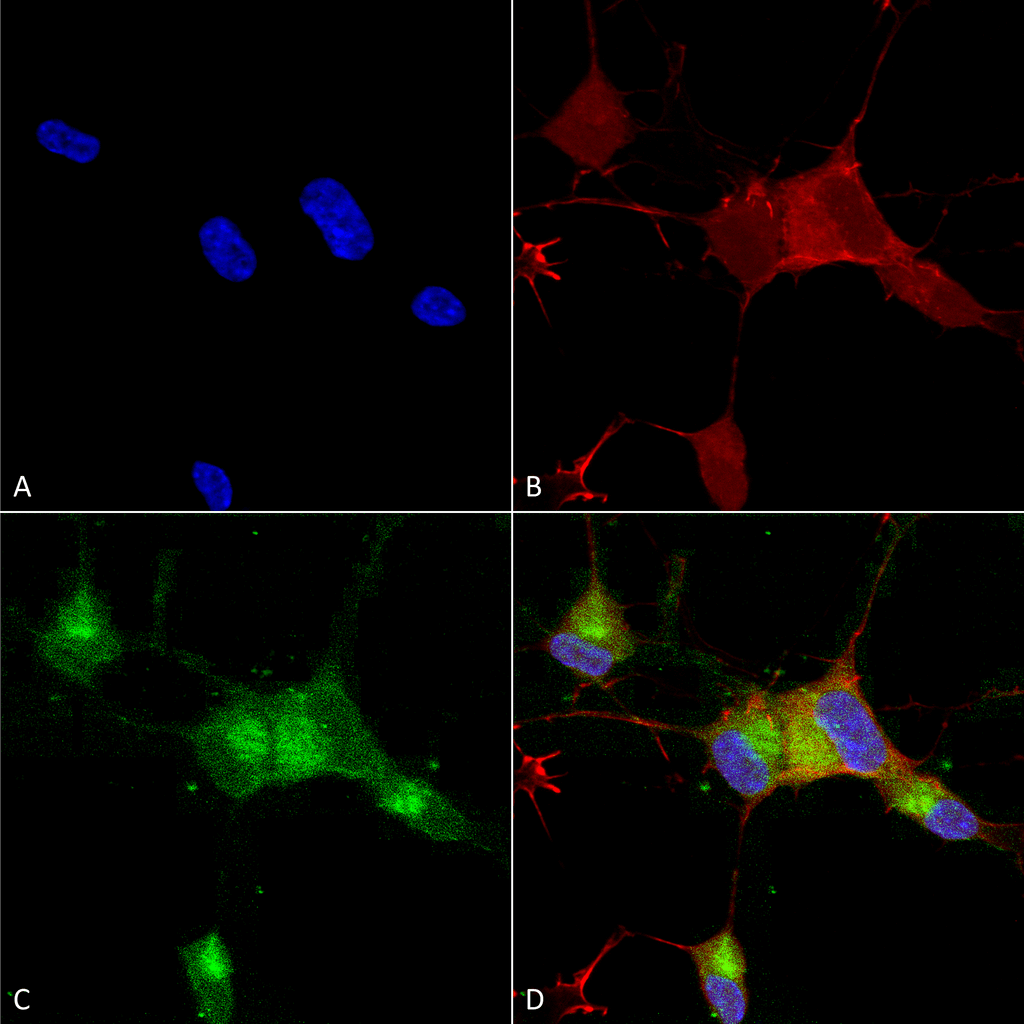
Immunocytochemistry/Immunofluorescence analysis using Mouse Anti-Nav1.7 Monoclonal Antibody, Clone N68/6 (SMC-314). Tissue: Neuroblastoma cells (SH-SY5Y). Species: Human. Fixation: 4% PFA for 15 min. Primary Antibody: Mouse Anti-Nav1.7 Monoclonal Antibody (SMC-314) at 1:100 for overnight at 4°C with slow rocking. Secondary Antibody: AlexaFluor 488 at 1:1000 for 1 hour at RT. Counterstain: Phalloidin-iFluor 647 (red) F-Actin stain; Hoechst (blue) nuclear stain at 1:800, 1.6mM for 20 min at RT. (A) Hoechst (blue) nuclear stain. (B) Phalloidin-iFluor 647 (red) F-Actin stain. (C) Nav1.7 Antibody (D) Composite.
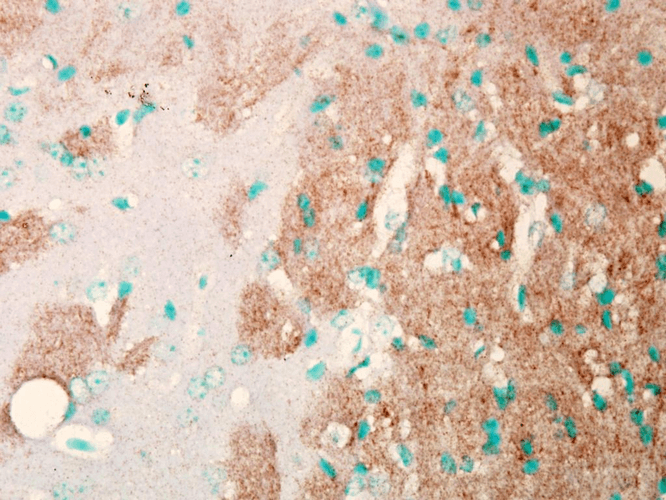
Immunohistochemistry analysis using Mouse Anti-Nav1.7 Sodium Channel Monoclonal Antibody, Clone N68/6 (SMC-314). Tissue: Brain Slice. Species: Mouse. Fixation: Frozen sections. Primary Antibody: Mouse Anti-Nav1.7 Sodium Channel Monoclonal Antibody (SMC-314) at 1:1000. Secondary Antibody: HRP/DAB Detection System: Biotinylated Goat Anti-Mouse, Streptavidin Peroxidase, DAB Chromogen (brown). Counterstain: Mayer Hematoxylin (purple/blue) nuclear stain.
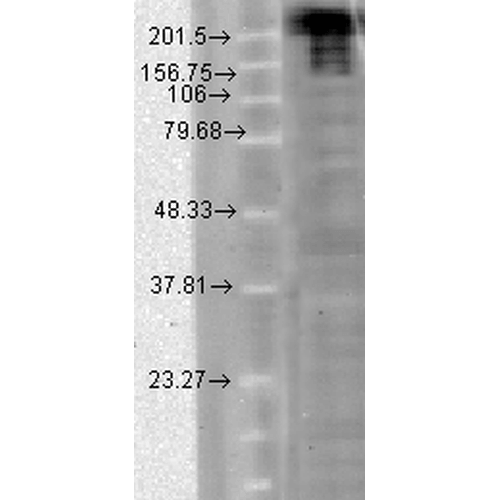
Western Blot analysis of Hamster CHO cells showing detection of Nav1.7 Sodium Channel protein using Mouse Anti-Nav1.7 Sodium Channel Monoclonal Antibody, Clone N68/6 (SMC-314). Load: 15 µg. Block: 1.5% BSA for 30 minutes at RT. Primary Antibody: Mouse Anti-Nav1.7 Sodium Channel Monoclonal Antibody (SMC-314) at 1:1000 for 2 hours at RT. Secondary Antibody: Sheep Anti-Mouse IgG: HRP for 1 hour at RT.
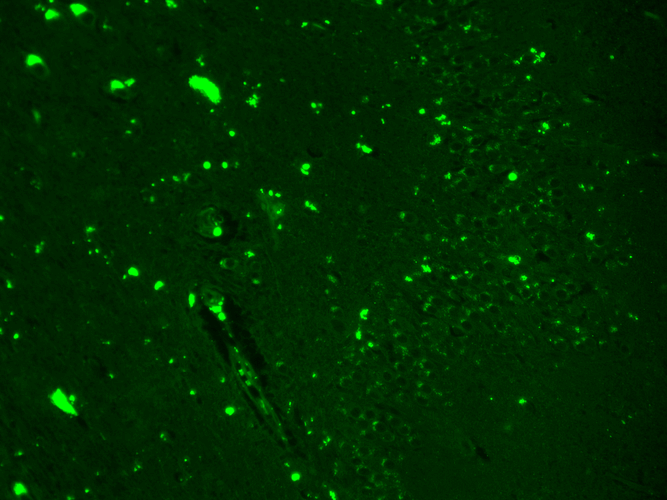
Immunohistochemistry analysis using Mouse Anti-Nav1.7 Sodium Channel Monoclonal Antibody, Clone N68/6 (SMC-314). Tissue: hippocampus. Species: Human. Fixation: Bouin’s Fixative and paraffin-embedded. Primary Antibody: Mouse Anti-Nav1.7 Sodium Channel Monoclonal Antibody (SMC-314) at 1:1000 for 1 hour at RT. Secondary Antibody: FITC Goat Anti-Mouse (green) at 1:50 for 1 hour at RT.
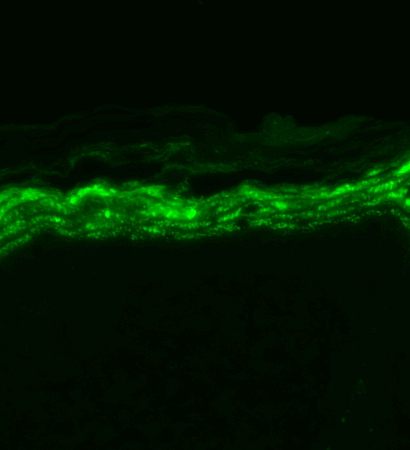
Immunohistochemistry analysis using Mouse Anti-Nav1.7 Sodium Channel Monoclonal Antibody, Clone N68/6 (SMC-314). Tissue: backskin. Species: Mouse. Fixation: Bouin’s Fixative and paraffin-embedded. Primary Antibody: Mouse Anti-Nav1.7 Sodium Channel Monoclonal Antibody (SMC-314) at 1:100 for 1 hour at RT. Secondary Antibody: FITC Goat Anti-Mouse (green) at 1:50 for 1 hour at RT.

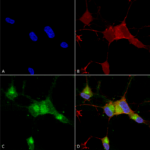




















StressMarq Biosciences :
Based on validation through cited publications.